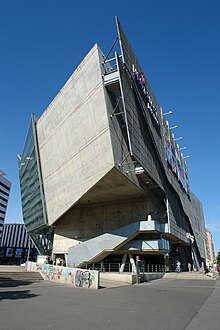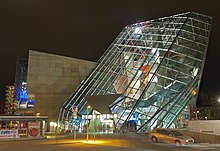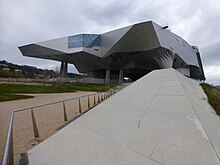Coop Himmelb(l)au
| Company type | GmbH |
|---|---|
| Founded | 1968 inVienna,Austria |
| Founders |
|
| Headquarters | Vienna ,Austria |
Key people |
|
| Services | Architecture, design |
Number of employees | 150 |
| Website | coop-himmelblau |
Coop Himmelb(l)au(a pun meaningCoop Sky BuildingandCoop Sky Blue) is an architecture, urban planning, design and art firm founded in 1968 byWolf D. Prix,Helmut SwiczinskyandMichael HolzerinVienna,Austria.[1][2]
History
[edit]Coop Himmelb(l)au was established in 1968 by Wolf D. Prix, Helmut Swiczinsky and Michael Holzer in Vienna and has been active in the fields of architecture, urban planning, design and art ever since. In 1988 a second studio was opened inLos Angeles.Further project offices are located inFrankfurt,Germany, andParis,France.
The architecture studio Coop Himmelb(l)au is now run by Wolf D. Prix, Harald Krieger, Karolin Schmidbaur and project partners. The project partners include Michael Beckert, Luzie Giencke, Andrea Graser, Helmut Holleis, Markus Pillhofer, Markus Prossnigg, Wolfgang Reicht, Frank Stepper and Michael Volk. Michael Holzer early left the office in 1971. Helmut Swiczinsky retired from operational business in 2001, and his final retirement was in 2006. Wolf D. Prix heads the studio as Design Principal / CEO.[1][2]From 2000 to 2011 Wolfdieter Dreibholz was managing director and partner of Coop Himmelb(l)au. Harald Krieger became partner and managing director of COOP HIMMELB(L)AU Europe GmbH in Frankfurt am Main in 2003. In 2011 he also took over the financial management of the studio as CFO. Karolin Schmidbaur became a partner in the office in 1996 and she is currently the design and managing partner of the office in Vienna (since 2009) and head of the studio in Los Angeles (since 2003).
The group's works were featured in the Museum of Modern Art'sDeconstructivist Architectureexhibition in 1988, curated by Philip Johnson and Mark Wigley. As a result, Coop Himmelb(l)au was henceforth included in the group of deconstructivist architects. The bureau never officially included itself in this group. However, certain working practices, such as collage, and the architectural language show similarities with other architects in this direction.
World-renowned institutions such as theGetty Centerin Los Angeles, theMuseum of Applied Arts, Vienna(MAK) and theCentre Pompidoushow works by Coop Himmelb(l)au in their permanent exhibitions. In 1996, Coop Himmelb(l)au was invited to represent Austria at the 6th InternationalVenice Biennale.Since then, the office has been represented there regularly and has presented projects such as the Musée des Confluences inLyonand theGuangzhou Opera House.TheMusée des Confluencesin Lyon was also presented from 2002 to 2003 at theLatent Utopiasexhibition inGraz.Coop Himmelb(l)au was also represented several times in theAedes East Galleryin Berlin, for example in the exhibitions Skyline 1985, The Vienna Trilogy + One Cinema 1998 and in an exhibition for the competition for the BMW Experience and Delivery Center in 2002. In In the same year Coop Himmelb(l)au was present at the 8th Architecture Biennale in Venice with theBMW Weltprojects and a design for thenew World Trade Center.In 2007/2008 the office was the subject of the exhibition COOP HIMMELB(L)AU. Beyond the Blue[3]of the MAK in Vienna. At the 11th Architecture Biennale in Venice, Coop Himmelb(l)au was represented with two contributions:Astroballon 1969 Revisited – Feedback Spacein the Arsenale and Brain City Lab in the Italian Pavilion. In 2009 the exhibition COOP HIMMELB(L)AU. Beyond the Blue could be seen at theWexner Center for the Arts,Columbus (Ohio).
Coop Himmelb(l)au was responsible for the design of several exhibitions, for exampleParadise Cage: Kiki Smith and Coop Himmelb(l)au,which was shown in 1996 at theMuseum of Contemporary Art, Los Angeles.One of the best-known is the exhibition Rudi Gernreich:Fashion will go out of Fashionfrom 2000 for the Styrian Autumn in Graz, which was later shown in Philadelphia.
In January 2022, the firm's partners were sanctioned by the president of Ukraine for illegally doing business in the Russian-occupied Crimean peninsula.[4][5][6]
Selected projects
[edit]




- 1966–1970: Villa Rosa, Wien[7]
- 1983–1988:Rooftop Remodeling Falkestrasse,Vienna, Austria
- 1992–2005:Academy of Fine Arts Munich
- 1993–1994:Groninger Museum,Groningen, Netherlands
- 1999–2001:Gasometer, Vienna,Austria
- 2001–2007:BMW Welt( "BMW World" ), Munich, Germany[8]
- 2007:Akron Art Museumaddition,Akron,Ohio, U.S.A.
- 2002–2008:High School for the Visual and Performing Artswith HMC Architects (Los Angeles Area High School #9, California, USA)
- 2008–2011:Busan Cinema Center,Busan,South Korea[9]
- 2010–2014:Musikkens HusinAalborg,Denmark
- 2010–2014: TheNew European Central Bankin Frankfurt together withGünther Vogt
- 2014:Musée des Confluences,Lyon,France
- 2010–2017: Museum „Paneum “in Asten, Austria
- 2015–2016:Alban Berg Monument, Vienna,Austria
Awards
[edit]- 2008:RIBA European AwardforBMW World
- 2005: AmericanArchitecture Awards
- TheChicago Athenaeum,Illinois
- Akron Art Museum,Ohio, US (2001–2006)
- 2004:Annie Spink Awardfor excellence in architectural education, RIBA, London, UK
- 2002: Gold Medal for merits to the federal state of Vienna, Austria
- 1992:Schelling Architecture Prize
See also
[edit]References
[edit]- ^abOverstreet, Kaley (15 November 2020)."The Early Days and the Enduring Legacy of Coop Himmelb(l)au".archdaily.Retrieved7 November2021.
- ^abZukowsky, John."Coop Himmelblau, European architectural firm".britannica.Retrieved7 November2021.
- ^"COOP HIMMELB(L)AU Beyond the Blue".mak.at(in German). Archived fromthe originalon 2012-05-28.Retrieved7 November2021.
- ^Scollon, Michael (2021-03-03)."Crimean Opera House Pulls Back Curtains On Russian Sanctions Loophole".RadioFreeEurope/RadioLiberty.Retrieved2022-01-25.
- ^Lahodynsky, Otmar (2020-12-11)."An illegal opera house for Sevastopol?".New Europe.Retrieved2022-01-25.
- ^"President of Ukraine Signs Decree on Sanctions Against Russian Enterprises".Ukraine open for business.2022-01-23.Retrieved2022-01-25.
- ^"Coop Himmelb(l)au Villa Rosa, 1966–1970".frac-centre.fr.Retrieved12 November2021.
- ^"COOP HIMMELB(L)AU BMW Welt project records".Canadian Centre for Architecture.RetrievedApril 8,2020.
- ^Busan Cinema Center, Korea: Busan International Film Festival Building,Retrieved September 30, 2011.
Further reading
[edit]- Fiell, Charlotte; Fiell, Peter (2005).Design of the 20th Century(25th anniversary ed.). Köln: Taschen. p. 178.ISBN9783822840788.OCLC809539744.
External links
[edit] Media related toCoop Himmelb(l)auat Wikimedia Commons
Media related toCoop Himmelb(l)auat Wikimedia Commons- Official site
- Coop Himmelblau architectural models and drawings for five projects, 1983–1995,Getty Research Institute,Los Angeles. Accession No. 2002.M.2. The five projects are: Open House, Malibu, California, 1983-circa 1990; Rooftop Office Remodeling, Vienna, 1983–1989; City Plan for Melun Sénart, France, 1987; Rehak House, Malibu, California, 1990-circa 1995; and Anselm Kiefer Studios, Buchen, Germany, 1990 and Barjac, France, 1992.
